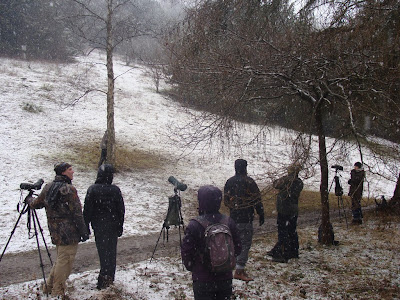There's that old stereotype about how Brits love to talk about the weather and it's true; why not, weather is pretty interesting isn't it?! It's certainly relevant at the moment and while the media scaremongering is beyond tiresome, it is tuned into the fact that everybody is thinking 'what the ****?!' It's not that a cold March is that unusual, I'm sure I can recall it snowing in April before now, but the scale and ferocity of these wintry conditions are hard to ignore. The Guardian ran an interesting article yesterday linking this weather to Arctic sea ice loss. It's worth reading - next time you're at the hairdresser's and find the conversation steered towards the weather, you'll be able to drop in some gems. I wonder if there's a positive side to all this, it's a general awakening to the idea of climate change in the mass public consciousness?
The weather seems to have added a particularly morose veneer to the political machine of late too. I shivered at this incredible exchange of words being battered about the blogosphere recently:
"The idea that the countryside should just hang out and hope for the best is wrong, and, as a result, we've got an imbalance. I haven't seen a peewit or a curlew around here for years. I'm clear that wildlife law should be built around management.'
As if on cue, a sparrowhawk streaks past the kitchen window and scatters his doves, and he nearly spills his coffee in annoyance. Pity the RSPB employee who recently invited him to look through a telescope at a sparrowhawk-‘ The answer was no, I wouldn't like to, seeing as one had just eaten my last goldfinch. People are obsessed with raptors.'"
Who said that? You got it - it was Secretary of State for Defra, Owen Paterson. The weather's not so bad now is it? You can read the article in 'CountryLife' here, it's hilarious, really.
The bleak and icy conditions today may also be apt for what is the first anniversary of the publication of the National Planning Policy Framework. Greg Clark MP, former planning minister, has been singing its praises on his blog : "The NPPF has succeeded in combining development with conservation, national standards with local empowerment...prophecies of an environmental apocalypse have not come to pass. The green belt is still very much in place, containing sprawl and ensuring that England remains green and pleasant." Thinking about my last post, I'm not sure I'd agree with that. Only one year on, this is really just the beginning, there are tough, relentless challenges for the environment ahead. The weather will improve eventually, the spin will stay the same, I just hope that in the rush for the lotion and the bucket and spade, we don't forget everything else.
On a brighter note, I headed out last weekend to see some Hawfinches! If you're a birder living anywhere in the vicinity of London, you will have heard about Mickleham and the incredible flock of finches currently frequenting the area. For birds more typically encountered in small flocks, the 110+ individuals that have been recorded here for the last few weeks is a remarkable occurrence. Whilst resident in the UK, albeit very locally, it seems a flock of this size must be swelled with, if not entirely consist of, continental birds - perhaps pushed into seeking new food sources by the harsh winter?
I scraped the ice off my car and headed round the M25 to Surrey on Saturday to have a look. Arriving around 8am in murky conditions, I found the spot at Juniper Bottom, closely followed by two more birders. If there was an upside to the cold and the gently falling snow, it was the stillness and the silence. Snow hung on the trees where nothing moved save tiny hidden voices every now and then. A Tawny Owl shrieked somewhere and a Song Thrush did its admirable best to lift spirits. For an hour an half I walked up and down the track, more in an effort to keep warm than anything, without sign of the birds until eventually I began to pick up some calls in a nearby fir. Another group of birders timed their arrival perfectly because within minutes, a flock of 11 birds suddenly left the shelter of the tree and swirled over our heads, this was followed a moment later by another large flock of c30 birds. Looking up into the sky, in between mouthfuls of sleet, I got decent views of this monster finch and it made the long, cold wait worthwhile. After a burst of activity, the flock disappeared from view and I was left to contemplate the wintery landscape.








